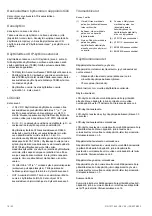
P/N 1077842 • REV 5.0 • ISS 03FEB12
3 / 52
Status LED indications
Figure 1 legend
(1) Green: The Power LED is on
when the control panel is
powered by the AC supply.
(2) Yellow: The Fault LED
illuminates to indicate
detection of a system fault.
(3) Blue: The Access LED
flashes when access to an
area assigned to the RAS is
granted.
(4) Red: The Alarm LED
illuminates when there is a
system tamper or an area
assigned to the RAS is in
alarm state.
(A) ATS1135 mounting points.
(B) ATS111X mounting points.
(C) BOX502E mounting points.
(D) BOX503E mounting points.
Operating features
Keyboard backlight and night light
The default keyboard backlight and night light settings are as
follows:
•
Keyboard backlight on (bright) for approximately 4 min
following a key press.
•
Night light on (dim).
These functions can be changed from the RAS menu.
LCD contrast
The LCD contrast may be adjusted by pressing and holding the
Menu key while momentarily pressing the
▲
or
▼
arrow keys
to change the LCD contrast. The default setting is 4.
LCD backlight
The LCD backlight illuminates for 30 seconds following a key
press.
LCD backlight intensity
The LCD backlight intensity may be adjusted by pressing and
holding the Menu key while momentarily pressing the
◄
or
►
arrow keys to change the LCD backlight intensity. The default
setting is 5.
Keypad backlight intensity
The keypad backlight intensity may be adjusted by pressing
and holding the 0 key while momentarily pressing the
▲
or
▼
arrow keys to change the keypad backlight intensity. The
default setting is 8.
Keypad nightlight intensity
The keypad nightlight intensity may be adjusted by pressing
and holding the 0 key while momentarily pressing the
◄
or
►
arrow keys to change the keypad nightlight intensity. The
default setting is 3.
Buzzer tone
The buzzer tone may be adjusted by pressing and holding the
X key while momentarily pressing the
▲
or
▼
arrow keys to
change the buzzer tone. The default setting is 16.
Buzzer volume
The buzzer volume may be adjusted by pressing and holding
the X key while momentarily pressing the
◄
or
►
arrow keys to
change the buzzer volume. The default setting is 6.
System fault buzzer
In case a system fault occurs (no communication with the
control panel) the text “System Fault” appears on the display
and the buzzer will be activated until any key is pressed. The
setting Auto is used to enable this feature for countries where
this is a requirement. The setting can also be set to On or Off.
The setting can be changed by holding the Menu key while
momentarily pressing the 0 key. Each next press of the 0 key
selects either Auto, On, or Off.
Power up
Upon initial power up, the buzzer will sound two beeps
indicating that the internal non-volatile memory is OK.
All areas must be disarmed in order to enable access to the
installer programming menu options.
Troubleshooting
General faults
No LED or LCD indication:
•
Verify the +13.8 and 0 V wire connections on both the
RAS and the power supply.
•
Verify power output on the DGP or external power supply.
Status LEDs are flashing and the LCD display reads System
Fault:
•
Verify the D+ and D
−
wire connections (may be reversed
or open circuit).
•
Verify the address DIP switches of the RAS is set to the
proper address.
•
Verify that the control panel is polling the RAS address.
RX and TX LED indicators
RX and TX LEDs are provided on the circuit board to assist in
fault diagnosis.
•
Rx: The yellow Rx LED flashes to indicate polling data is
being received on the system bus from the panel. If the
LED does not flash, the control panel is not operational or
the bus is faulty (usually cabling).
•
Tx: The red Tx LED flashes to indicate the RAS is replying
to polling from the control panel. If the Rx LED flashes but
the Tx LED does not, the RAS is not programmed to be
polled in the control panel or is addressed incorrectly.
Programming options
ATS1135 provide for a menu through which a number of
options can be set.
See Programming Map in Figure 5.
Note:
Only level 3 user (installer) is allowed to adjust the
keypad programming options.




































